Lava Xolo X900 Review - The First Intel Medfield Phone
by Brian Klug on April 25, 2012 6:00 AM ESTBattery Life
Nailing performance is one thing, but in order to really sell Medfield and other upcoming SoCs to OEMs, Intel has to deliver battery life and power consumption that's competitive. It's about performance/power in the SoC space. First, it's worthwhile to note that the X900 includes a relatively small battery, at just 5.4 Whr. Of late, batteries over 6 Whr seems like the norm, and I'm told that future designs including the Motorola phone will probably include larger ones. It's just good to have that frame of reference and this chart should help:
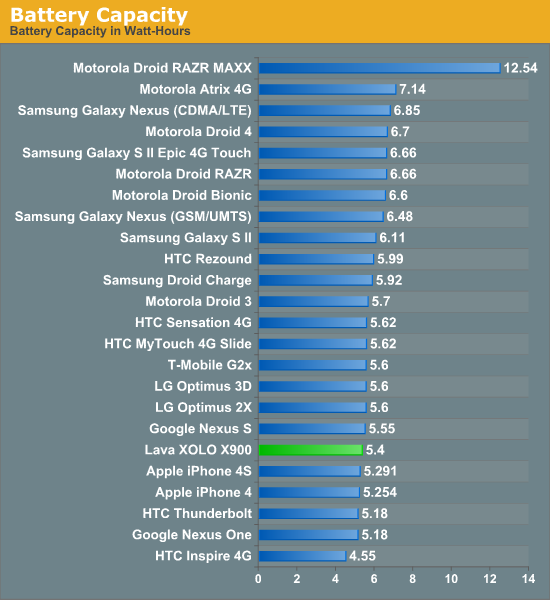
Intel notes battery life in their own X900 announcement blast as being around 5 hours of continuous 3G browsing and 8 hours of talk time. Our own numbers end up being pretty darn close, at 4.6 hours and 8.5 hours for those two metrics, respectively.
As a reminder, the browsing tests happen at 200 nits and consist of a few dozen pages loaded endlessly over WCDMA or WiFi (depending on the test) until the phone powers off. The WiFi hotspot tethering test consists of a single attached client streaming 128 kbps MP3 audio and loading four tabs of the page loading test through the handset over WCDMA with the display off.
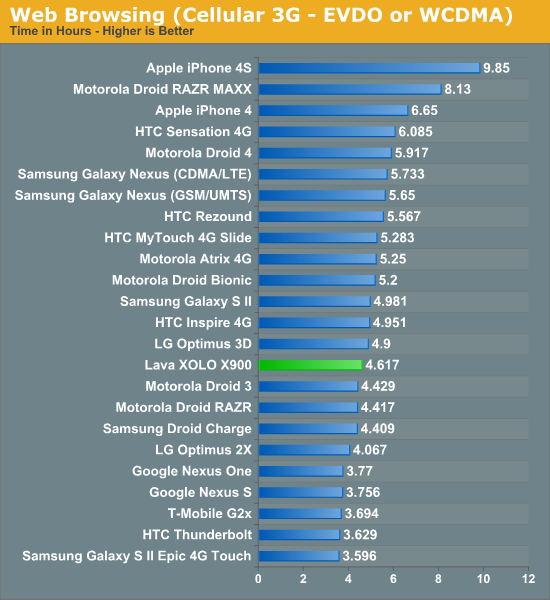
As a smartphone the X900 does a bit below average here, but as we mentioned it also has an unusually small battery for a modern flagship Android smartphone. If we divide battery life by battery capacity, we can get a better idea for how the Medfield platform compares to the competition:
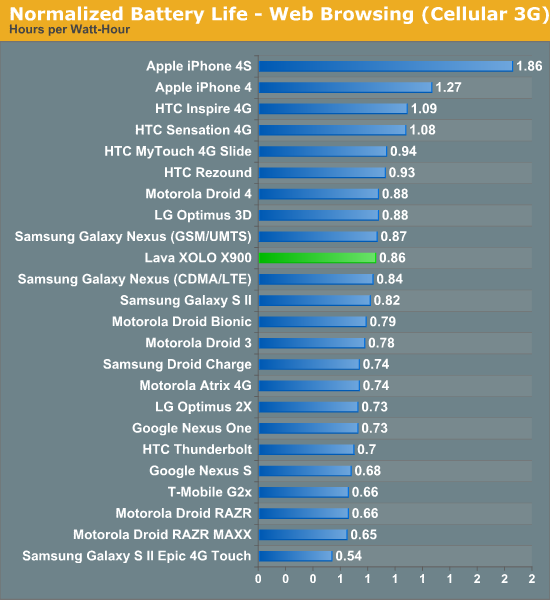
Normalizing for battery capacity, the X900 actually does a bit above average. In other words, the Medfield platform appears to be just as power efficient as some of the newer OMAP 4 based smartphones.
On WiFi the situation is no different:
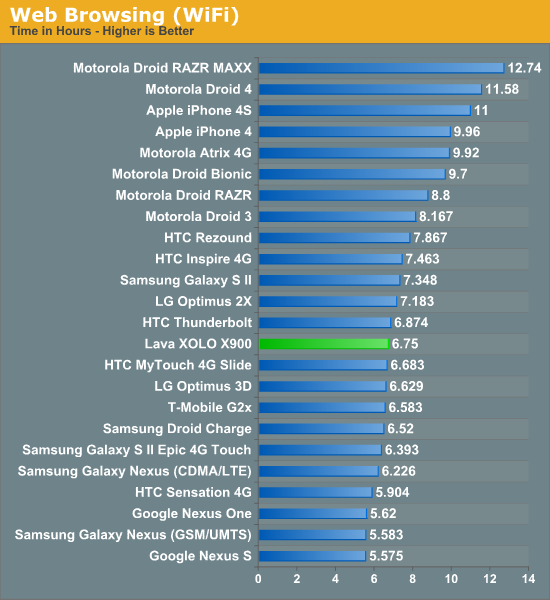
Again we see reasonable numbers for the X900 but nothing stellar. The good news is that the whole x86 can't be power efficient argument appears to be completely debunked with the release of a single device. To move up in the charts however, Intel needs to outfit its reference design with a bigger battery - something I've heard is coming with the Z2580's FFRD. The normalized results put the X900 at the middle of the pack:
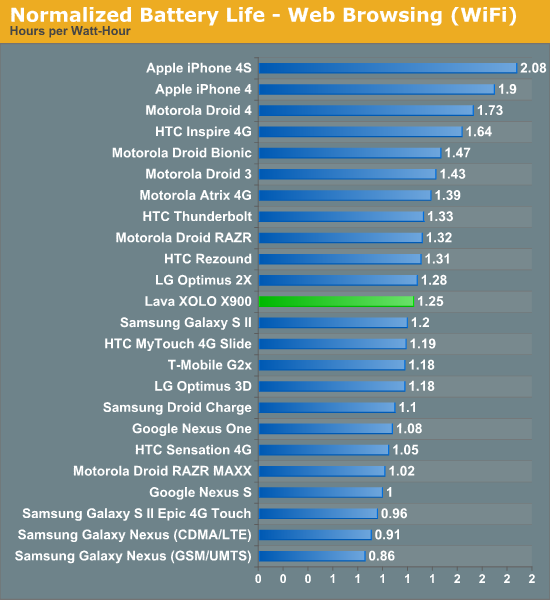
We see similar results in our talk time and 3G hotspot tests:

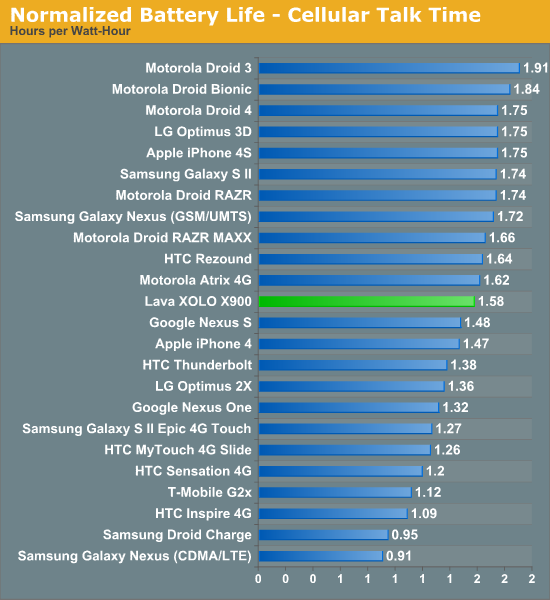
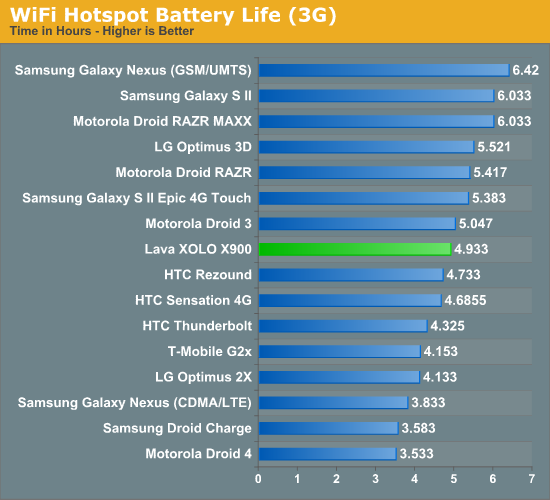
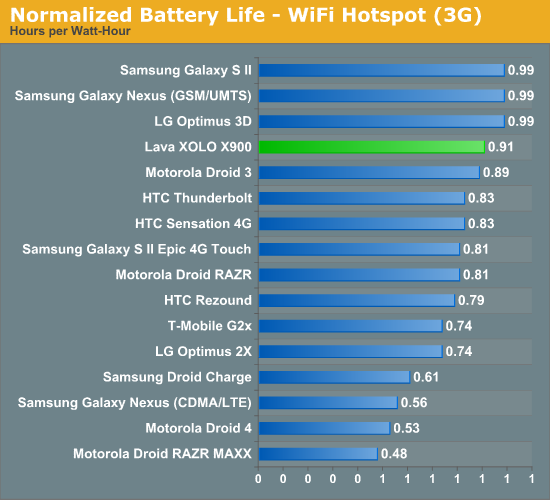










106 Comments
View All Comments
jed22281 - Thursday, April 26, 2012 - link
Vanilla MeeGo is nothing like MeeGo-Harmattan (aka Maemo6x) on the N9...The only relation Tizen has with Vanilla MeeGo, is that it's structured/administered in a similar fashion.
Plus many of the same partners involved in MeeGo, have moved to Tizen...
The developmental libraries/environment is totally different, although there's still some tacit support for Qt.
MeR+Nemo (& other UX's e.g. Cordia/Plasma etc) is what has supplanted the original MeeGo.
And yes you could in theory run MeR+Nemo or Tizen on this or other Medfied devices.
But I'm not so sure they'd necessarily be any less locked down than ARM-based ones.
Locked boot loader etc... But once that's out of the way, they'd have their advantages.
ironargonaut - Wednesday, April 25, 2012 - link
From what I see the only phones that best Intel in performance are not on the battery chart.If a phone computes something faster, will that not mean it can do more in less time? Thus, while the artificial surfing battery time is "average", wouldn't I be able to surf more pages and run more apps also in that same time period?
What is the power/performance metric?
fm123 - Thursday, April 26, 2012 - link
There is no clear way to tell from this, given that the CPU is likely ramping up and down. The other phones are not listed, I suspect, as they are new. They actually include newer battery saving features, so you can't see that yet on this comparison.ironargonaut - Thursday, April 26, 2012 - link
So,then could I safely say, that since battery life is not listed here, of the phones in both tests Intel has the highest cpu performance with midrange battery life.If they are not going to test the batteries of the same phones then you shouldn't have them listed on the same graph for CPU power. IMHO
It's like a Ford commercial saying Ford fullsize has better gas mileage then Chevy, more towing power than Dodge, more cargo space then Toyota etc..
Which if written the way of this article is more like Ford worse gas mileage than Dodge, less towing power than Toyota, less cargo space then Chevy etc...
All are misleading. IMHO
mcquade181 - Wednesday, April 25, 2012 - link
For the benefit of all us older technophiles with slightly less than perfect hearing, could you please, please test the earpiece volume when testing cellular phones?I had to ditch my otherwise great Nokia N8 because of its ridiculously low earpiece volume, which made it unusable in anything but perfectly quiet environments.
The other very useful test would be how well the phone operates in both voice and data modes in areas at the fringe of network coverage, i.e. the phone’s range. The Samsung Galaxy S2 does not fare that well in this test and is no where near as good as my old Nokia N8. Surprisingly, very, very few reviews of the Galaxy S2 mention how average its fringe reception is.
cmdrdredd - Wednesday, April 25, 2012 - link
To not include any iphone results to the GLbenchmark except offscreen since offscreen looks so great on the iphone and the results I've obtained from around the web when running on the phone's screen show it not to be that much better than the fastest Android devices. How many people ac tually do GPU functions that aren't running on the phone's screen? Not many...suman - Wednesday, April 25, 2012 - link
While BT is very cool technology, why is there so much hoopla around it. We released the Bluestacks App Player (beta) a month ago and have a binary translator embedded in it. We can run ARM NDK, X86 NDK, Dalvik applications side by side on our player.iamastranger - Thursday, April 26, 2012 - link
Basically all are missing a point here. It is a FFRD with miimal changes done by LAVA. Wait for a OEM like Moto deliver x86 based phone.danielt - Thursday, April 26, 2012 - link
Hoe come this site never review the amazing Galaxy Note?RajeevRaj - Thursday, April 26, 2012 - link
One aspect not touched upon here is the price of the XOLO as compared to the other smartphones in the compare list. The XOLO costs INR 22000 ($420). Most other phones in the list (which are available in India) cost upwards of INR 27-28000 (>$520). As example the Samsung Galaxy S2 costs INR 28-30,000 ($550) and iPhones cost upward of INR 35000. (>$700)So if you factor in a price to features ratio also in the comparisons, the XOLO looks very attractive for a smartphone buyer in India.